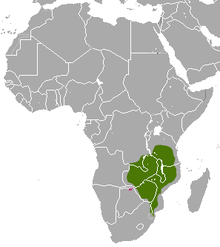Meller mongoose
| Meller mongoose | ||||||||||||
|---|---|---|---|---|---|---|---|---|---|---|---|---|

Drawing of a Meller mongoose by Joseph Smit |
||||||||||||
| Systematics | ||||||||||||
|
||||||||||||
| Scientific name of the genus | ||||||||||||
| Rhynchogale | ||||||||||||
| Thomas , 1894 | ||||||||||||
| Scientific name of the species | ||||||||||||
| Rhynchogale melleri | ||||||||||||
| ( Gray , 1865) |
The Meller mongoose ( Rhynchogale melleri ) is a species of predator from the mongoose family (Herpestidae) living in eastern Africa .
features
Meller mongooses reach a head body length of 44 to 50 centimeters, the tail is 28 to 41 centimeters long and their weight is 1.8 to 2.8 kilograms. The rear foot length is 9.5 to 10.6 centimeters and the ears are 3.1 to 4.3 centimeters long. As with all mongooses, their bodies are elongated and their limbs are rather short. The fur is gray to light brown on the upper side, the head and the underside are lighter, but the feet are darker. The color of the tail is variable. There are individuals whose tail is whitish or whitish-brown at the base and the rest of the tail is black and animals with black and white ringed tails with a black tip. The hairs of the dense undercoat are gray or gray-brown at the base and brown at the top. The hair on the head is 8 to 10 mm long and becomes longer and longer towards the trunk, where it can reach a length of 40 to 45 mm. At the tip of the tail, the hair is 9 to 11.5 mm long. On the paws, Meller mongooses have five toes with short, strongly curved claws on the front paws and longer, less curved claws on the hind paws. In contrast to most other mongooses, the soles of the hind legs are hairy. The females have two pairs of teats. The skull is delicate and half as wide as it is long. The eye sockets are directed forward. The upper canines are slender and sharp, the lower ones are stronger and more curved. The first premolars are very small. The upper scissor bite teeth are wide and similar to molars, the lower ones wide with clearly defined tips. Overall, the bit seems to be more suitable for crushing than cutting.
The tooth formula is: I3 / 3, C1 / 1, P 4/4, M 2/2.
Distribution area and habitat
These animals live in eastern Africa, their range extends from the southern Democratic Republic of the Congo and Tanzania through Zambia, Malawi, Mozambique and Zimbabwe to north-eastern South Africa . Their habitat is open forests, which are often dominated by Brachystegia species, savannas, more humid grasslands with termite mounds and the area around Vleis . In the South African Kruger National Park , the animals have also been observed in mountainous areas.
Way of life
Little is known about the way of life. The Meller mongoose is a nocturnal loner who mainly stays on the ground. Mneller mongoose feed primarily on insects, especially termites . Of 23 stomachs examined in Zimbabwe, all contained termite remains ( Macrotermes falciger , Macrotermes natalensis and Hodotermes mossambicus ), and grasshoppers , a black beetle , a centipede , a frog and the blind snake Leptotyphlops scutifrons were also found. Eating fruits has been observed in Malawi. Very little is known about reproduction either. Observations have shown that the females are likely to give birth to two or three young in November or December.
Danger
The Meller mongoose is included in the Red List of Endangered Species of the International Union for Conservation of Nature IUCN, but it is assessed as not endangered (“Least Concern”). It occurs in numerous protected areas.
literature
- Ronald M. Nowak: Walker's Mammals of the World . Johns Hopkins University Press, 1999 ISBN 0-8018-5789-9
supporting documents
- ↑ a b c d e Don E. Wilson , Russell A. Mittermeier : Handbook of the Mammals of the World - Volume 1 Carnivores. Lynx Editions, 2009, ISBN 978-84-96553-49-1 . Page 320.
- ↑ Rhynchogale melleri in the endangered Red List species the IUCN 2009 Posted by: Stuart, C. Stuart, T. & Hoffmann, M., 2008. Accessed January 27 of 2010.

